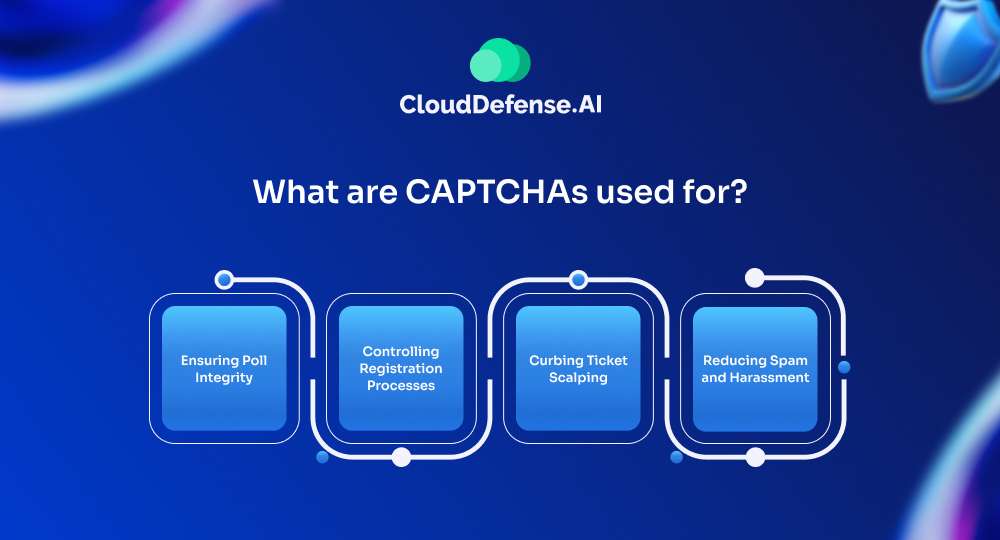What is a CAPTCHA?
A CAPTCHA, which stands for “Completely Automated Public Turing Test to Tell Computers and Humans Apart,” is a security measure used online to differentiate between real users and automated systems, such as bots. These tests are designed to be challenging for computers to solve but relatively easy for humans, ensuring that interactions are genuine and protecting against malicious automated activities.
CAPTCHA tests often involve presenting the user with a task that computers typically struggle with, such as identifying distorted letters and numbers or clicking on specific areas of an image. The classic form of CAPTCHA involves a randomly generated sequence of characters displayed in a distorted manner, which the user must correctly type into a provided text box.
This simple yet effective challenge-response mechanism helps prevent spam, protect against unauthorized access to accounts, and reduce the risk of automated attacks.
How does a CAPTCHA work?
CAPTCHAs function by presenting information that requires human interpretation, effectively distinguishing between human users and automated bots. Traditional CAPTCHAs typically display distorted or overlapping letters and numbers, which users must correctly input into a form field. This distortion makes it difficult for bots to interpret the text, preventing access until the characters are verified as correctly entered by a human.
The effectiveness of these CAPTCHAs lies in a human’s innate ability to recognize and generalize novel patterns based on varied experiences. Humans can easily decipher distorted characters, while bots, which often rely on fixed patterns or randomized inputs, struggle to do so accurately. This discrepancy in pattern recognition capabilities makes it highly unlikely for bots to guess the correct characters consistently.
New CAPTCHA Methods
The introduction of machine learning has led to the development of more complex bots capable of recognizing traditional CAPTCHA patterns through advanced algorithms. These machine-learning-driven bots have significantly improved their ability to decode even distorted text.
In response to these advancements, newer CAPTCHA methods have been developed to present more complex challenges. For example, reCAPTCHA may require users to click on specific areas of an image or perform tasks that involve waiting for a timer to run out. These newer methods use tasks that are simple for humans but remain challenging for bots, thus maintaining the effectiveness of CAPTCHAs in differentiating between genuine users and automated systems.
What are CAPTCHAs used for?

CAPTCHAs contribute significantly to the security and reliability of online interactions, ensuring that genuine users carry out activities such as voting, registering, purchasing tickets, and posting comments. Let’s learn more about its use cases.
1. Ensuring Poll Integrity
CAPTCHAs play a crucial role in maintaining the accuracy of online polls by ensuring that each vote is cast by a human. By requiring users to complete a CAPTCHA, websites can prevent bots from skewing poll results. While this measure does not limit the total number of votes, it increases the time required for each vote, discouraging multiple votes from a single user.
2. Controlling Registration Processes
Many services implement CAPTCHAs in their registration processes to combat the creation of fake accounts. This prevents bots from spamming registration systems and creating fraudulent accounts. By restricting account creation, CAPTCHAs help conserve a service’s resources and reduce opportunities for fraudulent activities.
3. Curbing Ticket Scalping
Ticketing systems use CAPTCHAs to prevent scalpers from purchasing large quantities of tickets for resale. This measure helps ensure fair ticket access and prevents false registrations for free events. CAPTCHAs deter automated systems from monopolizing ticket sales by making the purchasing process more time-consuming.
4. Reducing Spam and Harassment
CAPTCHAs effectively prevent bots from spamming message boards, contact forms, or review sites. Completing a CAPTCHA can also help reduce online harassment by adding a layer of inconvenience for those attempting to post malicious content. This helps maintain the quality and integrity of user-generated content on websites.
What is a reCAPTCHA?
reCAPTCHA is a free service provided by Google that serves as a more advanced alternative to traditional CAPTCHA tests. Originally developed by researchers at Carnegie Mellon University and acquired by Google in 2009, reCAPTCHA enhances the ability to distinguish between human users and automated bots.
Unlike typical CAPTCHA tests that present distorted letters and numbers for users to decipher, reCAPTCHA often utilizes real-world images. These images include street addresses, text from printed books, and excerpts from old newspapers, which are difficult for computers to interpret but relatively easy for humans.
Types of CAPTCHA
CAPTCHAs have evolved over time to include various methods for distinguishing human users from automated bots. Here are four main types of CAPTCHA that are commonly used:
1. Text-based CAPTCHAs
Text-based CAPTCHAs are the original form of CAPTCHA, relying on the user’s ability to recognize and interpret distorted text. These CAPTCHAs present characters in a way that involves scaling, rotation, or distortion, often combined with graphical elements like colors, background noise, lines, arcs, or dots to make recognition more difficult for bots. However, this can sometimes also make it challenging for humans.
2. Image-based CAPTCHAs
Image-based CAPTCHAs were developed to address some of the difficulties associated with text-based CAPTCHAs. These CAPTCHAs present users with recognizable images such as animals, shapes, or scenes, and typically require the user to identify images matching a theme or to select images that do not fit.
For example, a common image-based CAPTCHA might ask users to select all images that contain traffic lights. While these CAPTCHAs are generally easier for humans to interpret, they can pose accessibility issues for visually impaired users. Additionally, they are more challenging for bots because they require both image recognition and semantic understanding.
3. Audio CAPTCHAs
Audio CAPTCHAs provide an alternative for visually impaired users. These CAPTCHAs play an audio recording of a series of letters or numbers, which the user must then enter. They rely on the difficulty bots have in distinguishing relevant characters from background noise included in the audio.
Although designed to be more accessible, audio CAPTCHAs can still be difficult for both humans and bots to interpret, especially in noisy environments or for users with hearing impairments.
4. Math or Word Problems
Math or word problem CAPTCHAs present users with simple arithmetic problems or fill-in-the-blank sentences. For example, a user might be asked to solve “3+4” or complete a sequence like “dog, cat, ___.” These types of CAPTCHAs are accessible to visually impaired users and are relatively straightforward for humans to solve. However, they may be easier for advanced bots to solve compared to more complex CAPTCHA types.
Disadvantages of CAPTCHA
While CAPTCHAs are highly effective in distinguishing between human users and automated bots, they come with several disadvantages that can negatively impact the user experience on a website. Here are some key drawbacks:
1. Disruptive and Frustrating for Users
One of the primary disadvantages of CAPTCHAs is that they can be disruptive and frustrating for users. Completing a CAPTCHA adds an extra step to the process of accessing a website or service, which can be annoying, especially if the CAPTCHA is particularly challenging or if the user must attempt it multiple times. This added friction can lead to user frustration and may even drive users away from the website.
2. Difficult to Understand or Use for Some Audiences
CAPTCHAs can be difficult to understand or use for certain audiences, including individuals who are not tech-savvy, those with cognitive impairments, or users who are not fluent in the language presented by the CAPTCHA. Complex or unclear CAPTCHAs can be particularly challenging, making it harder for these users to successfully complete the test and access the desired content or service.
3. Browser Compatibility Issues
Not all CAPTCHA types are compatible with every browser. Some older browsers or less common ones may have trouble rendering CAPTCHAs correctly, leading to situations where users are unable to complete the CAPTCHA and proceed. This can be especially problematic in environments where users have limited options for updating or changing their browsers.
4. Accessibility Challenges
Many CAPTCHA types are not accessible to users who rely on screen readers or other assistive devices. For visually impaired users, text-based or image-based CAPTCHAs can be impossible to complete without assistance. While audio CAPTCHAs are intended to address this issue, they come with their own set of challenges, such as being difficult to understand in noisy environments or for users with hearing impairments. This lack of accessibility can prevent a significant portion of the population from being able to use websites that employ CAPTCHAs, leading to exclusion and frustration.
Final Words
CAPTCHA and its evolution play a vital role in maintaining online security by distinguishing human users from bots. Beyond protecting websites, they contribute significantly to the advancement of AI technologies.
By requiring millions of users to identify hard-to-read text and objects in images, these systems gather invaluable data that enhance AI’s ability to interpret and understand varied real-world contexts.
As CAPTCHAs continue to evolve, they protect digital interactions and advance machine learning capabilities, making technology more adept at navigating the complexities of our visual world.







